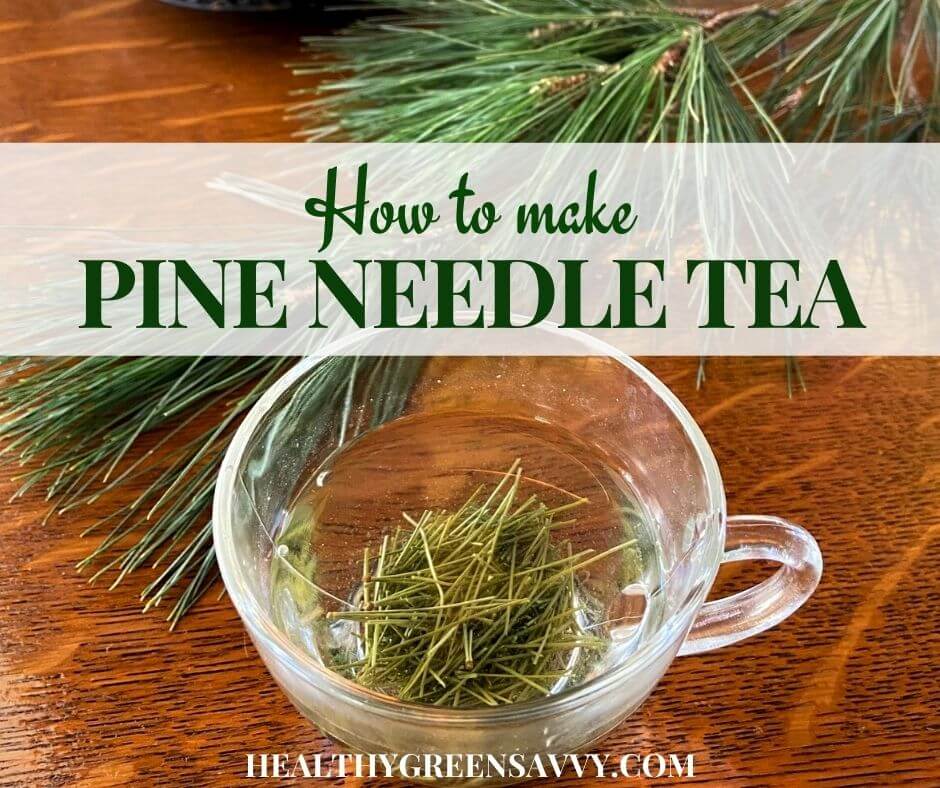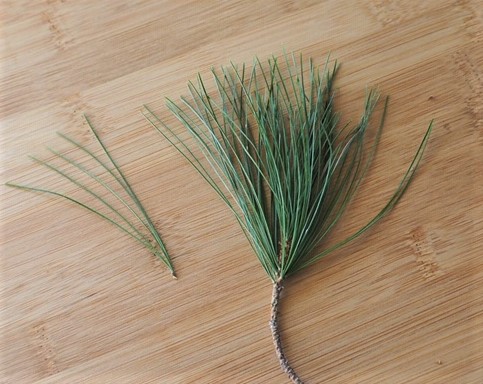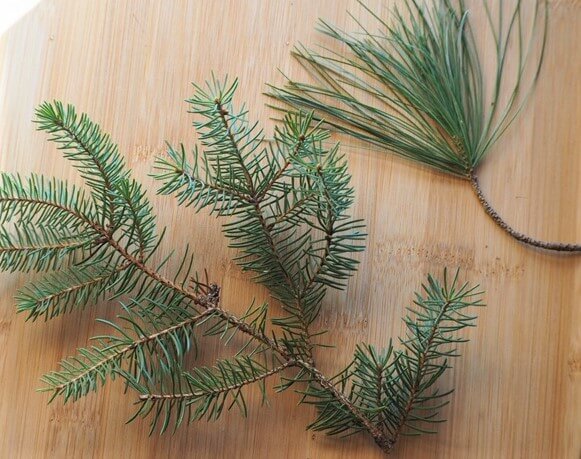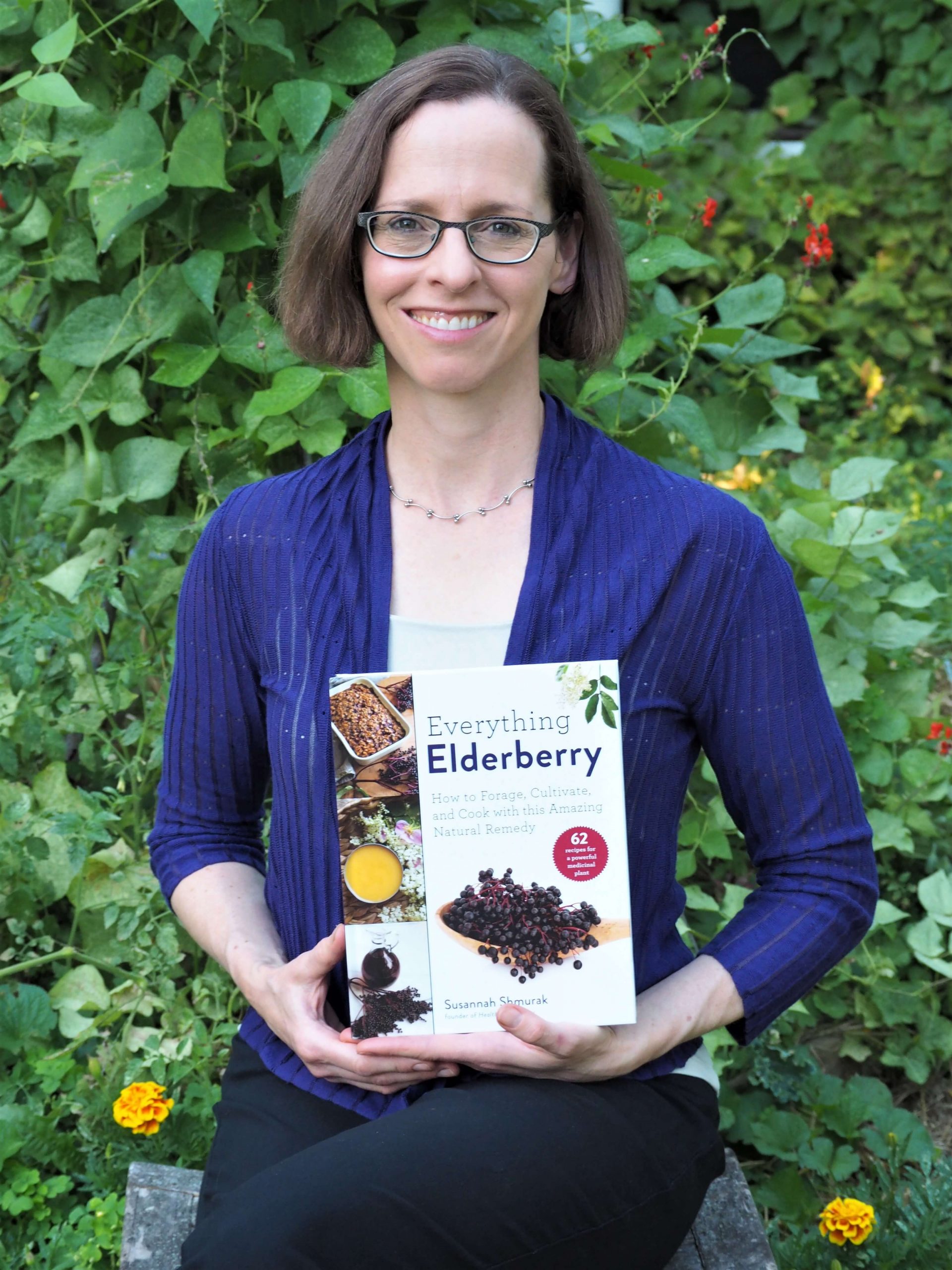Pine Tree Needles Vitamin C
Last Updated on December 2, 2021
Bright and refreshing pine needle tea not only tastes delicious, it's also rich in compounds linked to better health. And you can forage a nutritious cup of pine tea for free all year round!

WHY MAKE PINE NEEDLE TEA?
OK, I know a cup of pine needles might sound odd to some, but pine needle tea is really worth giving a chance. Here's why.
First of all, pine needle tea (also called just pine tea or sometimes white pine tea) is delicious, like drinking a little bit of the scent of a pine forest or fresh Christmas tree.
Second, pine needles have useful medicinal properties that make them helpful for supporting health and alleviating cold symptoms. (More details on the health benefits of pine needles below.)
Last, this delicious and healthy tea is free to any forager with access to a pine tree. Most people don't realize the trees around us offer ample foraging opportunities. In the case of evergreens, like pine and spruce, the fact they can be foraged all year long, when nothing else is growing, makes them all the more valuable. Here are more than 25 medicinal trees to explore if you're curious.
Is getting more knowledgeable about using herbs on your bucket list? Take advantage of the fantastic sale Herbal Academy has on right now. All their courses are up to 40% off for the holidays. An herbal course would make a great gift, either for you or for someone on your list. Find out more here.

I happen to have a spruce tree growing in my yard, so spruce tea is something I make often in the colder months, when all my home-grown herbs have long since died.
I love that spruce and pine offer opportunities for fresh herbal tea any time of year. In summer, I use lemon balm, mint, and other perennial herbs in sun tea. I also harvest some of the new spruce tips in late spring.
Wondering what else you might be able to forage in your yard? You probably have a number of edible weeds like dandelions, purslane, wild violets, and creeping Charlie, as well as numerous flowers you can eat.
Making the most of these easily-foraged ingredients can help you eat seasonally all year round. And since pine is always in season, pine tea lets you enjoy seasonal eating at any time of year.
Get more savvy tips to help you live greener and healthier every day by following HealthyGreenSavvy on Facebook and Pinterest, where you'll find easy health hacks, eco-living essentials, and simple healthy recipes shared daily.
PINE NEEDLE TEA BENEFITS
Like elderberries and other long-standing plant medicines, the active compounds in pine needles have undergone some intriguing research. I'll bet you never realized the power your pine trees might have to benefit your health.
Pine needles have been used by herbalists and native peoples for centuries. Some of pine needles' medicinal properties include:
- anti-inflammatory
- pain reliever
- antimicrobial
- decongestant
- expectorant
Other parts of the pine are also edible and medicinal, but that's the subject of another post. Below are some of the benefits scientists have studied to date about the benefits of pine needles.

1. PINE NEEDLES ARE RICH IN POLYPHENOLS
Like so many other potent medicinal plants, pine needles contain compounds called flavonoids, which are known to benefit health.
Studies suggest that pine needles contain a-pinene, which may aid memory, alleviate anxiety, and help with depression, though these animal studies cannot directly demonstrate these pine needle benefits for humans.
2. PINE NEEDLE TEA CONTAINS ANTIOXIDANTS
Antioxidants help our bodies deal with something called oxidative stress, which can affect proteins and DNA in ways that may contribute to chronic disease, like cancer and inflammatory conditions like arthritis.
Pine needles, like many other foods rich in antioxidants, contain compounds that may help reduce oxidative stress, which can lower our risk of many chronic diseases. (Additional studies here, here, and here.)
One study looking at the potential benefits of pine needles found that "pine needles exhibit strong antioxidant, antimutagenic, and antiproliferative effects on cancer cells and also antitumor effects in vivo and point to their potential usefulness in cancer prevention."
3. PINE NEEDLES ARE A SOURCE OF VITAMIN C
Like spruce, pine needles contain vitamin C, which is why it's long been used as an effective remedy for scurvy. (You may find mention of Jacques Cartier's crew using pine to treat scurvy, but that appears to have been arborvitae, which is a different genus of conifer.)
I've seen numerous claims that the vitamin C in pine needles exceeds that in lemons and oranges, but not one of them cites their sources. One study cited in this article found differing amounts of vitamin C in different types of pine, and while some are quite high, it's worth remembering that you're not likely to eat 100 grams of pine needles the way you would 100 grams of orange.
Another source found that the vitamin C levels in the pine needles analyzed wasn't very high, but consumed in pine tea they seem to have enough to help with scurvy.
However much vitamin C it contains, pine needle tea isn't just useful for scurvy. You probably know that vitamin C plays an important role in immune system function, so it's useful for fighting colds. Here's a complete list of immune-boosting foods to incorporate into your diet regularly to help you stay healthier during cold and flu season.
Researchers at the University of Maine found that pine needles steeped in hot water readily released shikimic acid, one of the key ingredients in the antiviral drug Tamiflu, though of course a cup of pine needle tea will have only a tiny amount of this compound compared to a dose of Tamiflu.
You'd have to consume an awful lot of pine needle tea to take in significant amounts of these compounds. But adding an easily foraged tea to your herbal tea rotation will help you expand the range of polyphenols you get in your diet, always a good thing. And as a herbal remedy for coughs and colds, a steaming cup of pine needle tea may provide some much-needed relief. Immune-boosting elderberry tea is another great option. Here are more effective home remedies for cough.
Curious about other medicinal plants you might grow in your yard? Here are more than 45 options to consider for your medicinal herb garden.
Note: Pregnant women are advised to avoid spruce and pine tea.

IDENTIFYING PINES FOR PINE NEEDLE TEA
The first rule of foraging is ALWAYS to make a positive identification before harvesting. Though some people refer to all evergreens as pines, there are actually many different types of conifer, and not all are safe to consume.
There are over 100 species of pine in the genus pinus growing around the world, and they share an easy-to-identify feature: clusters of long needles, usually found in groups of 2-5 called fascicles.
If you find an evergreen with individual leaves coming directly out of the branch, you don't have a pine, but likely a spruce or fir. You'll see these used in a lot of blog posts purportedly about pine needle tea, but they're technically making a spruce or fir tea. More than you wanted to know, perhaps, but it's irksome when people share foraging information and don't bother to check they're correct.

The cluster of 5 needles is held together by a brown papery covering where it meets the branch

The cutting of spruce on the left shows the different pattern of needles, which attach individually rather than in clusters like pine
Eastern White Pine (Pinus strobus, pictured above) grows widely in North America, and can be easily identified by its clusters of 5 needles, while red pines have 2 and yellow pines have 3. Count the needles on more than one cluster in case a needle has fallen from the cluster.
Here's more on distinguishing different conifers from Iowa State Extension. This post on conifer identification from Grow Forage Cook Ferment is also very informative.
Always consult a good field guide for foragers or enlist a local expert so you know what you're collecting.
Here are some of my favorite foraging books.
Since correctly identifying the specific type of pine you have can be a little tricky, this identification tool from the Arbor Day Foundation can help you distinguish exactly which pine you've got. Make sure it's not one of those to avoid listed below.
If you'd like to know more about safe foraging, you might consider taking a foraging class, like the Herbal Academy's online foraging course , which teaches plant identification and ethical wildcrafting practices.

–> Avoid the trees below when foraging for pine needle tea. Note that though some are sometimes popularly referred to as pines, they're not actually in the same family:
- Yew Plum Pine or fern pine (Podocarpus macrophylla)
- Norfolk Pine or Norfolk Island Pine (Araucaria heterophylla)
- Cypress (Cupressus) (More on issues of edibility here.)
- Yew (Taxus)
Another non-pine with pine in its name is the Australian Pine (Casuarina equisetifolia). Here's more on uses for it from Eat the Weeds.
Here's how to identify yews and why to make sure to avoid them. This video also has a good description of what to look for to make sure you don't accidentally harvest this poisonous plant. You can find more of Professor Waterson's videos on additional conifers here.
A much-cited study of cattle fed large quantities of ponderosa pine found that pregnant cows were more likely to miscarry on a diet of ponderosa pine, leading to assertions that ponderosa pine is unsafe for consumption by pregnant women. Though concerns about ponderosa pine may be overblown, most experts recommend caution with many herbs in pregnancy because of the lack of safety data.
Ponderosa pines have 2-3 needles per cluster. Lodgepole or Shore Pine (Pinus contorta) also has conflicting information about its edibility, so skip it if you have concerns.
If you want to be extra-cautious, using needles from trees with 5 needles per cluster means you'll be using only white pine for tea.
Get more savvy tips to help you live greener and healthier delivered straight to your inbox when you sign up for our newsletter. Get a library of free e-books as a welcome to the HealthyGreenSavvy community. Sign up here.
HARVESTING NEEDLES FOR PINE TEA
Once you've correctly identified your local pine trees, you're ready to collect needles for your pine tea.
Harvest needles from a tree that hasn't been sprayed with chemicals, which may mean avoiding public parks or yards where homeowners spray their lawns with herbicides.
If you're foraging from your Christmas tree, make sure it wasn't sprayed, as many commercial growers spray their Christmas trees.
Gather needles sparingly, as the tree needs plenty of needles to stay healthy. Take a few bunches of needles from several trees rather than lots all from one tree.
Many foragers prefer the flavor of younger needles, which you'll find toward the end of the branches. I've read that the older needles may have more vitamin C, but I haven't found any study supporting that claim.
If you don't have ready access to a pine tree and want to collect extra when you find one, you can use dried pine needles for pine tea.
Many readers have asked about purchasing pine needles for pine tea. These sellers on Etsy ship fresh and dried pine needles.
How much pine needle to use: Some pine needle tea drinkers suggest dunking the tip of a branch into boiling water, while others suggest chopping the needles and using a couple of tablespoons per cup of water. Different trees will have different flavors, and the flavor can vary with the season as well. There isn't just one 'right' way to make pine tea, so do what works for you.
You'll likely get more out of your pine needle tea if you chop the needles to help release their medicinal compounds. I also recommend making your tea too strong and diluting it rather than using too little pine and having a weak, tasteless tea you won't want to drink.
–>Pour freshly boiled water over needles rather than boiling your pine needles on the stovetop to preserve medicinal compounds.
I find pine needle tea lovely on its own without sweetener, but if you prefer sweeter tea, add a little honey or other sweetener to taste.
Prep Time 2 minutes
Cook Time 15 minutes
Total Time 17 minutes
Ingredients
- 1/3 cup chopped pine needles
- 2 cups boiled filtered water
- Optional: honey or other sweetener to taste
Instructions
- Collect pine needles from trees you've positively identified as pines, and not from the trees to avoid mentioned above.
- Remove needle clusters from the branch and rinse.
- Chop or snip pine needles into small pieces, discarding the brown covering holding the needle cluster together.
- Place chopped needles in a teapot or cup and cover with freshly boiled water.
- Allow to steep 10-15 minutes, strain and enjoy.
Notes
Different pine needles will have different flavors and intensity. Add more pine needles for stronger flavor and less if you find the flavor too strong.
Nutrition Information:
Yield:
2 cups (unsweetened) Serving Size:
1
Amount Per Serving: Calories: 0 Total Fat: 0g Saturated Fat: 0g Trans Fat: 0g Unsaturated Fat: 0g Cholesterol: 0mg Sodium: 9mg Carbohydrates: 0g Fiber: 0g Sugar: 0g Protein: 0g
I hope you love this simple pine tea — please leave a comment if you try it and let me know what you think.
If you like foraging ingredients for delicious herbal teas, here are some other ideas:
- Elderflower Tea
- Elderberry Tea
- Mulberry Tree Leaf Tea
- Dandelion Tea (from leaves, flowers, or roots)
- Ginkgo Biloba Tea
- Nettle Leaf Tea
Pin to save this pine needle tea recipe for later!

Disclaimer: I'm a health & foraging enthusiast, not a medical professional. Content on this website is intended for informational purposes only and is not meant to provide personalized medical advice. I draw on numerous health sources, some of which are linked above. Please consult them for more information and a licensed professional for personalized recommendations.

Susannah is a proud garden geek and energy nerd who loves healthy food and natural remedies. Her work has appeared in Mother Earth Living, Ensia, Northern Gardener, Sierra, and on numerous websites. Her first book, Everything Elderberry, released in September 2020 and has been a #1 new release in holistic medicine, naturopathy, herb gardening, and other categories. Find out more and grab your copy here.
Source: https://www.healthygreensavvy.com/pine-needle-tea-how-make-benefits/

Tidak ada komentar: